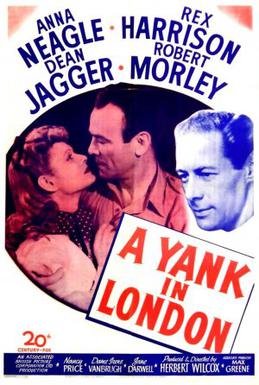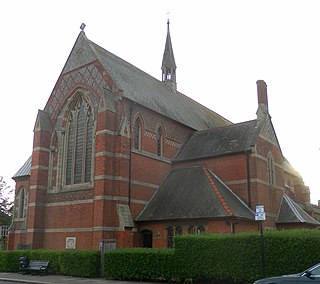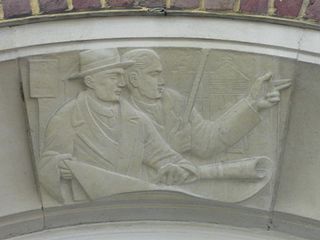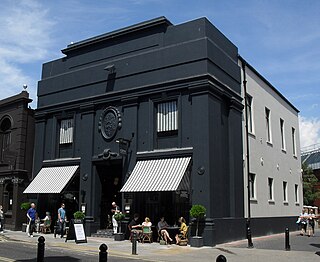Related Research Articles

Hove is a seaside resort in East Sussex, England. Alongside Brighton, it is one of the two main parts of the city of Brighton and Hove.

Brighton City Airport, also commonly known as Shoreham Airport, is located in the parish of Lancing in West Sussex, England. It has a CAA Public Use Aerodrome Licence that allows flights for the public transport of passengers or for flying instruction.

Hangleton is a suburb of Brighton and Hove, in the ceremonial county of East Sussex, England. The area was developed in the 1930s after it was incorporated into the Borough of Hove, but has ancient origins: its parish church was founded in the 11th century and retains 12th-century fabric; the medieval manor house is Hove's oldest secular building. The village became depopulated in the medieval era and the church fell into ruins, and the population in the isolated hilltop parish only reached 100 in the early 20th century; but rapid 20th-century development resulted in more than 6,000 people living in Hangleton in 1951 and over 9,000 in 1961. By 2013, the population exceeded 14,000.

Mile Oak is a locality forming the northern part of the former parish of Portslade in the northwest corner of the city of Brighton and Hove, England. Now mostly residential, but originally an area of good-quality agricultural land, it covers the area north of Portslade village as far as the urban boundary.

I Live in Grosvenor Square is a British comedy-drama romance war film directed and produced by Herbert Wilcox. It was the first of Wilcox's "London films" collaboration with his wife, actress Anna Neagle. Her co-stars were Dean Jagger and Rex Harrison. The plot is set in a context of US-British wartime co-operation, and displays icons of popular music with the purpose of harmonising relationships on both sides of the Atlantic. An edited version was distributed in the United States, with two additional scenes filmed in Hollywood, under the title A Yank in London.

St Andrew's Church is a former Anglican church in the Brunswick Town area of Hove, part of the English city of Brighton and Hove. It is in the care of the Churches Conservation Trust, the national charity protecting historic churches at risk.

St Philip's Church is a Church of England parish church in Hove, in the city of Brighton and Hove, England. It was opened in 1895 and consecrated in 1898 on New Church Road, near Aldrington's parish church of St Leonard's. It has come under threat of closure but is still active as of 2012. It is a Grade II listed building.

Hove Methodist Church is one of five extant Methodist churches in the city of Brighton and Hove, England. Founded on a site on Portland Road, one of Hove's main roads, in the late 19th century by a long-established Wesleyan community, it was extended in the 1960s and is now a focus for various social activities as well as worship. The red-brick building has been listed at Grade II by English Heritage in view of its architectural importance.

Brighton and Hove, a city on the English Channel coast in southeast England, has a large and diverse stock of buildings "unrivalled architecturally" among the country's seaside resorts. The urban area, designated a city in 2000, is made up of the formerly separate towns of Brighton and Hove, nearby villages such as Portslade, Patcham and Rottingdean, and 20th-century estates such as Moulsecoomb and Mile Oak. The conurbation was first united in 1997 as a unitary authority and has a population of about 253,000. About half of the 20,430-acre (8,270 ha) geographical area is classed as built up.

Barford Court is a care home operated by the Royal Masonic Benevolent Institution and situated on the seafront in Hove, part of the English city of Brighton and Hove. The building, completed in 1937, has had this function only since 1996; it was constructed by cinema architect Robert Cromie as a private house for Ian Stuart Millar, an eccentric iron industry tycoon, who occupied it for only nine years. The large building later accommodated the Brighton and Hove School of Nursing, which for the first time brought together training provision for all local hospitals' staff on one site. When the school moved away in 1989, the house spent several years on the market awaiting a buyer—and in steadily deteriorating structural condition—before being refurbished, extended, renamed and converted to its present use.

The English coastal city of Brighton and Hove, made up of the formerly separate Boroughs of Brighton and Hove in East Sussex, has a wide range of cemeteries throughout its urban area. Many were established in the mid-19th century, a time in which the Victorian "cult of death" encouraged extravagant, expensive memorials set in carefully cultivated landscapes which were even recommended as tourist attractions. Some of the largest, such as the Extra Mural Cemetery and the Brighton and Preston Cemetery, were set in particularly impressive natural landscapes. Brighton and Hove City Council, the local authority responsible for public services in the city, manages seven cemeteries, one of which also has the city's main crematorium. An eighth cemetery and a second crematorium are owned by a private company. Many cemeteries are full and no longer accept new burials. The council maintains administrative offices and a mortuary at the Woodvale Cemetery, and employs a coroner and support staff.

John Leopold DenmanFRIBA was an architect from the English seaside resort of Brighton, now part of the city of Brighton and Hove. He had a prolific career in the area during the 20th century, both on his own and as part of the Denman & Son firm in partnership with his son John Bluet Denman. Described as "the master of ... mid-century Neo-Georgian", Denman was responsible for a range of commercial, civic and religious buildings in Brighton, and pubs and hotels there and elsewhere on the south coast of England on behalf of Brighton's Kemp Town Brewery. He used other architectural styles as well, and was responsible for at least one mansion, several smaller houses, various buildings in cemeteries and crematoria, and alterations to many churches. His work on church restorations has been praised, and he has been called "the leading church architect of his time in Sussex"; he also wrote a book on the ecclesiastical architecture of the county.

The Hounsom Memorial Church is a United Reformed place of worship in Hove in the English city of Brighton and Hove. One of six churches of that denomination in the city, it was built in 1938 for the Congregational Church, which became part of the United Reformed Church in 1972. Its name commemorates William Allin Hounsom, a local man and longstanding member of the Congregational church in central Hove, who had wide-ranging business interests and landholdings across Sussex. The red-brick building, one of many local works by Brighton-based architect John Leopold Denman, is embellished with carvings that have been called "quite startling for a Nonconformist church".
Clayton & Black were a firm of architects and surveyors from Brighton, part of the English city of Brighton and Hove. In a career spanning the Victorian, Edwardian and interwar eras, they were responsible for designing and constructing an eclectic range of buildings in the growing town of Brighton and its neighbour Hove. Their work encompassed new residential, commercial, industrial and civic buildings, shopping arcades, churches, schools, cinemas and pubs, and alterations to hotels and other buildings. Later reconstituted as Clayton, Black & Daviel, the company designed some churches in the postwar period.
Flight Lieutenant Cecil Frederick "Jimmy" Rawnsley was a Royal Air Force night fighter observer radar operator and gunner during the Second World War. He flew many of his sorties with John "Cat's Eyes" Cunningham who was credited with 20 kills, of which 19 were claimed at night, and 17 of which were achieved with Rawnsley.

Adelaide Crescent is a mid-19th-century residential development in Hove, part of the English city and seaside resort of Brighton and Hove. Conceived as an ambitious attempt to rival the large, high-class Kemp Town estate east of Brighton, the crescent was not built to its original plan because time and money were insufficient. Nevertheless, together with its northerly neighbour Palmeira Square, it forms one of Hove's most important architectural set-pieces. Building work started in 1830 to the design of Decimus Burton. The adjacent land was originally occupied by "the world's largest conservatory", the Anthaeum; its collapse stopped construction of the crescent, which did not resume until the 1850s. The original design was modified and the crescent was eventually finished in the mid-1860s. Together with the Kemp Town and Brunswick Town estates, the crescent is one of the foremost pre-Victorian residential developments in the Brighton area: it has been claimed that "outside Bath, [they] have no superior in England". The buildings in the main part of Adelaide Crescent are Grade II* listed. Some of the associated buildings at the sea-facing south end are listed at the lower Grade II.
Gilbert Murray Simpsonfriba (1869–1954) was a British architect from Brighton who did most of his work in the seaside resort. In 1890 Simpson joined his father Thomas, architect to the Brighton and Preston School Board and the Hove School Board, and helped to design some of the "distinguished group of board schools" for those institutions during the late 19th century. He took over the firm of Thomas Simpson & Son when his father died in 1908, and went on to design several other institutional buildings in Brighton. His elder brother Sir John William Simpson was also an architect.

The English coastal city of Brighton and Hove has a long and varied history of libraries going back over 250 years. Subscription libraries were among the earliest buildings in the resort of Brighton, which developed in the late 18th century; by the 1780s these facilities, which were more like social clubs than conventional book-borrowing venues, were at the heart of the town's social scene. The Brighton Literary Society, its successor the Brighton Royal Literary and Scientific Institution and its rival the Sussex Scientific Institution between them established a "very fine collection" of publications by the mid-19th century, and these books were donated to the town when a public library was founded in 1871. Neighbouring Hove, originally a separate village, established its own public library in 1890.

Brighton and Hove, a city and unitary authority in the English county of East Sussex, has a wide range of public services funded by national government, East Sussex County Council, Brighton and Hove City Council and other public-sector bodies. Revenue to fund these services comes partly from Council Tax, which is paid annually by residents: this tax provides the city council with nearly 20% of its income and also helps to fund the local police force, Sussex Police, and the county's fire service, East Sussex Fire and Rescue Service. Some of Brighton and Hove's utilities and infrastructure are provided by outside parties, such as utility companies, rather than by the city council.
References
- 1 2 3 Middleton 2002 , Vol. 2, p. 87.
- ↑ "Jean Peacock biography".
- ↑ Brandon, Lewis (1961). Night Flyer. ISBN 9780907579779.
- ↑ Middleton 2002 , Vol. 1, p. 25.